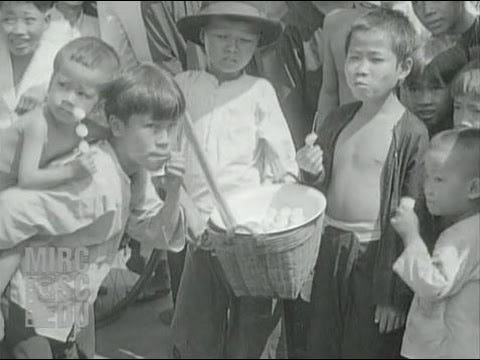Below are the highlights and some descriptions to give a bit more cultural context:
0:43 - Here is a shaved ice vendor with some jars of candy in the background. Men’s hair styles haven’t changed too much. A customer is wearing a very large wide brimmed hat, which would have been very popular among the ethnically Chinese. A short while later, you see a young man (older brother) wearing a baggy tan suit with a hat similar to Pith Helmets, often worn by expats.
1:33 - Some women sidewalk vendors selling fruits and vegetables with the woman in the front wearing the traditional checkered scarf worn by people of the countryside, often seen in tourists markets all over Vietnam today. In the background we see the first rickshaw runners waiting for their passengers. Cut to the next scene, we see the transportation system of Colonial Vietnam.
2:08 - Here is the old hop on, hop off bus system.
2:14 - A Chinese boy serving treats to some local children. The younger children have the typical shaved heads and small puff of hair at the front top which we still see among countryside children today. They are wearing the traditional linen outfits with the old time knot buttons. This simple style is mostly reserved for observant Buddhists today. Quick cut to another street scene.
3:03 - Some expats wearing the expat colonial uniform of Pith helmet along with tan linen suits. The building might be the Continental hotel at Rue Catinat. Before synthetic fibers, linen was the way to go in the tropics as it was the most breathable fabric available. Across the street today, those buildings are some of the most expensive shops in Ho Chi Minh City, with brands such as Hermes and Patek Philippe occupying the storefronts. Some venders come by to sell some expensive souvenir animal skins while a prospective European customer carefully tests the skins by pulling and stretching the skins to test for the curing quality. You don’t want it too brittle or it will fall apart shortly after coins trade hands
3:36 - A colonial European man is discussing something with the locals while a doorman or his assistants are in the background, one wearing a hat which appears to be a Songkok hat, common among Muslim males in South East Asia of the era.
4:09 - A rickshaw runner in action with his Colonial fare. The customer pays, but clearly the runner has a dispute over the payment, perhaps he thinks it isn’t enough, or maybe he wants to ensure a return trip. Quickly another Colonial man comes by to send the runner on his way. There is a cut away scene and the runner is back again with the customer offering payment, but obviously the runner wants more. What do you want runner? …obviously a language barrier.
6:26 - This is a cafe and I believe the men are American, based upon the Fedora hats, often worn by American or British men in the 1940’s.
7:03 - Jump to a couple different groups enjoying some afternoon cocktails. I hear French, English and Spanish at the same table, so perhaps they are playing the language upmanship game.
8:13 - There are some more rickshaw runners. This time, one of the runners seems to be disappointed with his fare, so he asks for a bit more, but the European man turns away and appears to toss some money on the sidewalk before a waiter or bellman comes by to give the runner group the old brush off.
10:03 - Here is an outdoor kitchen which appears to be selling soup. Not much has changed. These soup restaurants are still all over the place and look nearly identical today.
10:23 - We see a cart vender, appearing to sell drinks to local children. A brawl nearly breaks out as the young children push to be the first in line and nearly push over the cart.
11:39 - A woman showing off her lovely sunbrella.
…Just a few observations.
It is very interesting that before this recent wave of globalization, it was much easier to identify ethnic or cultural groups based upon their dress. When I watch these videos, it is clear that not much has changed, while at the same time, much has changed. There are still arguments with Taxi drivers and many of the hairstyles are still fashionable to this day (or maybe I should say they have returned). Clothing styles and transportation have changed dramatically. …and …oh yeah, now everyone walks around staring at these little rectangular boxes in their hands.



The drinking glasses are handled like the tea cups today in the phở and most other restaurants... they drink from the glass while standing there and then put it back. The vendor gives it to the next customer without washing it.
I like the donkey carts outside Ben Thanh Market. Safer than many taxis today. I wonder if the locals compared the odor of the donkeys to the odor of the French and other foreigners?
Almost all the locals are barefoot. I wonder when shoes became common?
The guy who shorted the rickshaw driver at 8:36 reminds me of the f-ing expats today who bitch about paying 5% more than the locals in the market when the locals obviously need it more than they do. I hope he's rotting in whatever hell there might be.